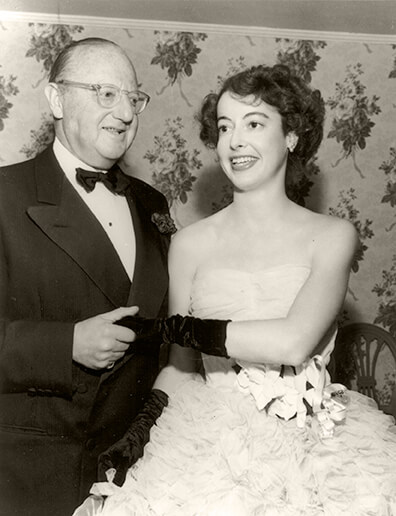A Short Biography of Jesse L. Lasky

by Betty Lasky
JESSE L. LASKY was one of the pioneers of Hollywood’s motion picture industry. Born in San Francisco, California, on September 13, 1880, the son of shoe-store proprietor Isaac Lasky, his early years were characterized by failure. Growing up in San Jose, he learned to play the cornet and imagined he would be discovered by John Philip Sousa; Sousa never heard him. In 1899 he followed his hero, Jack London, to Nome, Alaska, after the gold rush, but gold eluded him. In 1901 he sailed to Hawaii and became one of the few non-Hawaiians to play in the Royal Hawaiian Band.
Returning home broke, he turned to vaudeville, performing a duo-cornet act with his sister, Blanche, and then started to produce high-class musical vaudeville acts in New York. These were the lush days of vaudeville and the money rolled in. Success in vaudeville led to the loss of Lasky’s first fortune in the Folies Bergère, a lavish Broadway theater-restaurant he built, with Henry B. Harris, that failed after four months. It was a lucky failure, for his destiny lay in Hollywood.
In 1913 the Jesse L. Lasky Feature Play Co. was launched with Lasky as president, his best friend Cecil B. DeMille as director-general, and brother-in-law Samuel Goldfish (later Goldwyn) as general manager and treasurer. Lasky never dreamed their first movie, The Squaw Man, Hollywood’s first feature-length film, would lay the foundation stone of a great industry.
For Lasky, unlike other movie pioneers, California was a homecoming. More than that, it was a state of mind—an attitude that influenced almost every aspect of his daily life. He took pride in being a native son of a native son: his father was born in Sacramento where his grandfather had settled in 1848, after a covered wagon crossing on the Oregon Trail.
The Lasky Company, established in Hollywood in a barn on Selma Avenue and Vine Street, prospered and grew into Famous Players-Lasky following a propitious merger—later to become mighty Paramount. Lasky called the years he ruled Paramount (1916-1932), with his fiscal-minded partner Adolph Zukor, “the best years of my life.”
He signed stars such as Rudolph Valentino, Maurice Chevalier and Bing Crosby, and supervised over one thousand films. Many bore the personal stamp of Lasky's love of adventure and sense of the romantic, and revealed his intense pride in his American heritage—none more so than The Covered Wagon, the great western epic; The Rough Riders, with the glitter and pomp of Col. Teddy Roosevelt and his motley band of fighters; Old Ironsides, a flag-waving vision of Tripoli and pirates and sea battles aboard the gallant old “Constitution”; The Vanishing American, an inspiring portrayal of the passing of the American Indian; Beau Geste, a spectacular rendering of the adventure, romance and mystery of life in the French Foreign Legion; and Wings, spine-tingling epic of the light-hearted flying fighters of World War I, which won the first Academy Award.
During the Depression era, Lasky and his company crashed. On the comeback trail as an independent producer he fought to make the films he believed in. Films like The Power and the Glory, a precursor of Citizen Kane, brought Spencer Tracy to stardom. Berkeley Square, a sensitive, provocative work, considered at the time in a class by itself, gave Leslie Howard one of his most outstanding roles. In the 1940s, Lasky launched a series of screen biographies: Rhapsody in Blue, The Adventures of Mark Twain and Sergeant York. The latter, a glorious, soul-rousing movie the critics unanimously called “a cinemasterpiece,” became an overnight box-office smash and earned Gary Cooper an Academy Award. Lasky was on top again; still he fought almost a losing battle to bring The Great Caruso to the screen. The movie made a star of Mario Lanza, a mint for MGM—and vindication to its creator, Lasky, for his belief that “a picture with an operatic theme could prove profitable.”
Next, Lasky fought to instill his vision of young America on the march to the tune of high school bands, in the closed minds of Hollywood’s studio heads. It was too late for his last impossible dream. The IRS had a stranglehold on him after snatching his winnings from Sergeant York. The genial, gentlemanly showman who represented Hollywood at its best died heavily in debt, his final film project, The Big Brass Band, a dream unrealized.
Maintaining his courage and enthusiasm to the end, he said, “You’re never broke if you have an idea.”
He died in Beverly Hills, California, January 13, 1958.
—Betty Lasky (2001)
